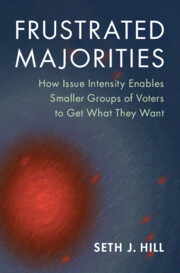Book contents
- Frontmatter
- Contents
- Figures
- Tables
- Theorems
- Acknowledgments
- Part I Frustrated Majorities, Issue Intensity, and Political Action
- Part II Argument: an Intensity Theory of Electoral Competition
- Part III Evidence: Empirical Patterns and Intensity Theory
- 6 Introduction to Empirical Evidence
- 7 Politicians Side with Intense Minorities
- 8 Issues of Intensity Explain Vote Choice
- 9 Opening Avenues of Costly Action: Institutional Change to Costs of Campaign Contributions
- 10 Closing Avenues of Costly Action: Reform to Primary Elections
- Part IV Conclusions
- Part V Appendices
- Bibliography
- Index
- Other books in the series
7 - Politicians Side with Intense Minorities
from Part III - Evidence: Empirical Patterns and Intensity Theory
Published online by Cambridge University Press: 15 September 2022
- Frontmatter
- Contents
- Figures
- Tables
- Theorems
- Acknowledgments
- Part I Frustrated Majorities, Issue Intensity, and Political Action
- Part II Argument: an Intensity Theory of Electoral Competition
- Part III Evidence: Empirical Patterns and Intensity Theory
- 6 Introduction to Empirical Evidence
- 7 Politicians Side with Intense Minorities
- 8 Issues of Intensity Explain Vote Choice
- 9 Opening Avenues of Costly Action: Institutional Change to Costs of Campaign Contributions
- 10 Closing Avenues of Costly Action: Reform to Primary Elections
- Part IV Conclusions
- Part V Appendices
- Bibliography
- Index
- Other books in the series
Summary
This chapter explores two case histories where American politicians appear to have sided with intense minorities over less-intense majorities. First, I present the case of federal funding for stem cell research in the early 2000s. I find evidence that majorities supported allocating federal health research funds toward research using embryonic stem cells yet federal policy remained stringent for most of the decade. Second, I present the case of firearm regulation following the mass shooting at Sandy Hook Elementary School in 2012. Although large majorities indicated support for new regulation of firearms, no new regulations passed Congress. An intense minority appears to have used costly political action to communicate their strong opposition to new regulations.
Keywords
- Type
- Chapter
- Information
- Frustrated MajoritiesHow Issue Intensity Enables Smaller Groups of Voters to Get What They Want, pp. 104 - 117Publisher: Cambridge University PressPrint publication year: 2022

